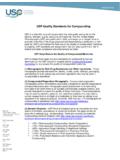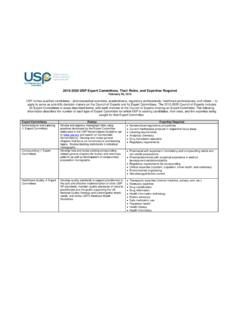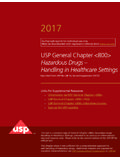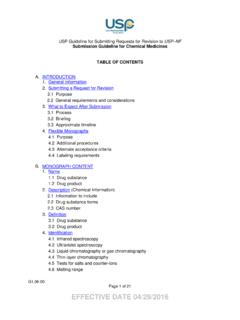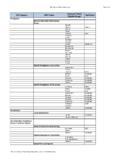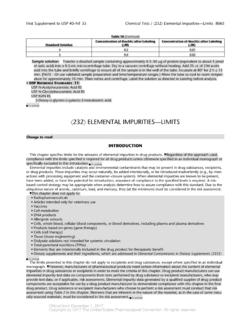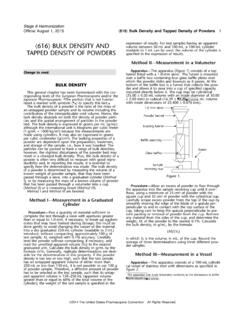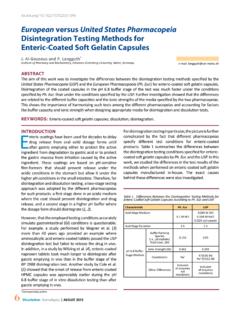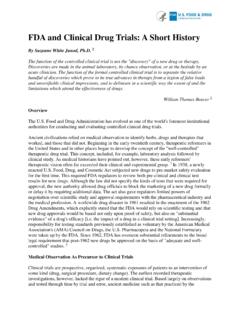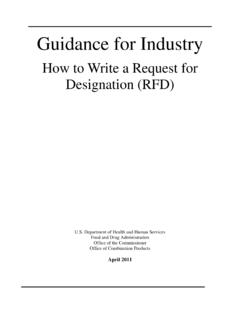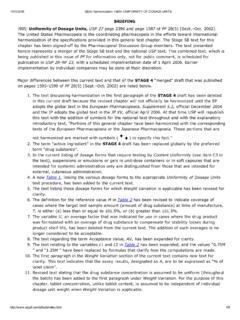Transcription of U.S. Pharmacopeia National Formulary USP 39 NF 34
1 USP 39 Published General Chapter <1132> Residual Host Cell Protein Measurement in BiopharmaceuticalsThe official version can be found in the USP NF. The USP NF is subscription based publication. For more information on how to access the USP NF click 39NF PharmacopeiaNational FormularyOfficial: May 1, 20162016 USP 39 THE UNITED STATES PHARMACOPEIANF 34 Volume 1 THE National FORMULARYBy authority of the United States Pharmacopeial ConventionPrepared by the Council of Experts and its Expert CommitteesOfficial from May 1, 2016 The designation on the cover of this publication, USP NF 2016, is for ease ofidentification only. The publication contains two separate compendia: The UnitedStates Pharmacopeia , Thirty-Ninth Revision, and The National Formulary , UNITED STATES PHARMACOPEIAL CONVENTION12601 Twinbrook Parkway, Rockville, MD 20852 Although safety concerns regarding residual DNA impurities are not as prominent as they once were, the levels of residualDNA in any bioprocess remain a key quality attribute and help define the process.
2 1132 Residual Host Cell Protein Measurement in Biopharmaceuticals1. INTRODUCTION AND SCOPEMany medicinal products are produced through recombinant technology via a host cell ( , bacteria, yeast, or mammali-an, insect, or plant cell lines). During the manufacture of such products, some amount of non-product, host cell-derived mate-rial will inevitably be introduced into the process stream. This process results in a mixture of the desired product and host cell-derived impurities, including host cell proteins (HCPs), and other process-related impurities that will be targeted for clearancethrough HCPs have the potential to affect product quality, safety, and efficacy; therefore, the quantity of HCPs should below. The product purification processes must be optimized to consistently remove as many HCPs as feasible, with the goal ofmaking the product as pure as primary concern with HCPs in biopharmaceutical products is their potential to induce anti-HCP antibodies that couldinduce a clinical effect in patients.
3 In addition, HCPs may possibly act as adjuvants, which can induce anti-drug antibodies thatcan affect the safety or efficacy of the drug. A more extensive discussion of immunogenicity and its effect on preclinical andclinical studies is described in USP general chapter Immunogenicity Assays Design and Validation of Immunoassays to Detect An-ti-Drug Antibodies 1106 . HCPs can also have a direct effect on the quality of the product itself. For example, proteolytic HCPs,even in minute quantities, can cleave the desired protein product over time, reducing or eliminating biological potency or al-tering chapter focuses on HCP immunoassays for recombinant therapeutic products. It does not address products such as vac-cines or gene-, cell-, or tissue-based therapies, although the general principles discussed may apply to the measurement ofHCPs in these products. The design and validation of immunoassays for HCPs involve unique and significant challenges due to:1) the wide variety of possible HCPs in medicinal products; 2) the general use of polyclonal antibody reagents to detect them;3) the lack of exactly matched standards for quantitation; 4) in some cases, a considerable effect from sample dilution effects;and 5) inherent limitations to measure single HCP chapter includes assay development strategies throughout the product and process development lifecycle, and it de-scribes approaches to demonstrate that the assay is fit for use ( , illustrates unit operation clearance of HCPs, lot release).
4 Because of the complexity of HCP immunoassays, careful development and characterization of critical reagents are required,particularly for the immunogen used to elicit the anti-HCP antibodies, the antibody reagent(s), and the assay HCP HCP testing is an essential part of process development and product quality control, HCP testing is also discussed inconjunction with regulatory requirements and other considerations for guidance on an overall control strategy for HCPs. Abrief outline of the general chapter follows:1. Introduction and Considerations for Manufacturing, Characterization, and Consistency2. Terminology3. HCP Immunoassay The Assay Development Development and Characterization of HCP Immunoassay Method Development and Qualifying as Fit for Use4. HCP Immunoassay Method Sensitivity and Assay Sample Specificity5. Supporting Technologies for Residual HCP Detection, Identification, and Considerations for Electrophoretic Considerations for Western Blot Considerations for Chromatographic and Proteomic Concluding Remarks on Supporting Technologies for HCPs6.
5 Use of HCP Immunoassays for Process Development, Characterization, and Assays for Individual Control Strategy7. Summary and Conclusions8. BibliographyGeneral Chapters1416 1130 Nucleic Acid-Based Techniques / General InformationUSP Considerations for Manufacturing, Characterization, and ConsistencyDifferent cell-based expression systems are used to manufacture medicinal products, such as bacteria (Escherichia coli, Pseu-domonas fluorescens), yeast (Saccharomyces cerevisae, Pichia pastoris), mammalian cells ( , Chinese hamster ovary (CHO),mouse myeloma cell line NSO, and others), insect cells (baculovirus-infected Spodoptera frugiperda cells), and plant cells (to-bacco, Arabidopsis, rice). The particular HCP profile is unique and specific to the particular host cells under specific culture con-ditions and manufacturing processes. HCPs can vary in pI (~3 11) and hydrophobicity, and HCPs display a wide range of mo-lecular weights (from ~5 kDa to at least ~250 kDa), depending on the host cell and manufacturing process used.
6 The numberof HCPs in upstream samples can run anywhere from several hundred to more than one thousand proteins, depending on thehost cell and culture conditions. Although many cellular hosts have been used in biopharmaceutical manufacturing historically,the most experience has been gained using E. coli and the mammalian cells CHO, NSO, SP2/0, and human embryonic kidneycell line HEK293. The guidance in this chapter draws most heavily from the experience with these expression systems; howev-er, general principles apply broadly to any host cell mammalian cells, the recombinant protein is typically secreted from the cells into the cell culture fluid (CCF), along withmany of the HCPs. However, it has been observed that intracellular protein trafficking may not proceed in a normal fashion inproduction cultures. For example, proteins usually associated with intracellular organelles, such as lysosomes, may be found inthe CCF of largely viable cell cultures, because the clones have been selected for maximum protein export.
7 In addition, assome of the cells die, their soluble, intracellular proteins are released into the CCF. Some harvest operations also lyse cells;therefore, the resulting harvested CCF typically contains both secreted and intracellular HCPs. While this mixture of proteinsincubates in the fermenter, additional changes in the HCP population may occur, for example, as the result of enzymatic activ-ity ( , proteinases or sialidases).HCP assays provide important information about the composition of the material entering the downstream recovery processand how each purification step affects HCP clearance. In some cases, HCPs can even bind to, and co-purify with, certain prod-ucts. Process characterization and validation studies are needed to show which process steps remove HCPs and also to demon-strate the robustness of these steps for consistently removing HCPs. As such, HCP assays are an essential part of purificationprocess development and help ensure manufacturing consistency.
8 Lastly, reproducible and reliable HCP assays may be re-quired to measure residual HCPs remaining in the drug substance (DS) used to make drug product (DP) that is delivered to thepatient. HCP levels should be measured in: 1) preclinical lots used in toxicology assessment, 2) all lots during clinical develop-ment, and 3) process validation samples from the final manufacturing process. After approval, HCP monitoring may be re-quired as an element of the control system. Subsequent sections of this chapter discuss in more detail the use of HCP assays inprocess validation and in a good manufacturing practices (GMP) control TERMINOLOGYTo help establish a common nomenclature in the literature and with regulatory agencies, Table 1 lists common terms withtheir definitions (indicating how they are used in this chapter) in addition to synonyms that have been used historically. Notethat the term platform indicates that the same set of standards and reagents is used within a company to test a variety ofproducts made from the same type of expression system ( , CHO cells) grown under similar upstream conditions.
9 In thecase of platform HCP assays, the antibodies to HCP are obtained from animals immunized with HCP antigens generated from acommon upstream process that is applicable to many products, even if the downstream purifications are different. This ap-proach allows the knowledge from prior products to be leveraged. Justification that an assay is suitable for a new product,using the same expression system and common upstream conditions, is therefore often relatively HCP immunogen used to generate platform anti-HCP antibodies and used often as the assay calibration standard is, bydesign, comprised of a broad set of HCPs. In contrast, the qualifier process-specific indicates that the immunogen/standardhas been prepared from a set of HCPs unique to a given process (either a unique upstream cell culture process or a uniquedownstream purification process). Process-specific assays are, therefore, limited in their utility, and each must be fully qualifiedfor each process.
10 Process-specific immunogens and calibration standards are, by intent, more narrow and specific to a givenprocess. Commercially available assays produced by vendors are often derived from a combination of strains and harvest/purification procedures, and these assays are intended to have a broad application; but these commercially available assays arenot specifically designed for a given manufacturer s proprietary cell line, and users do not have control over reagent availabilityand lot-to-lot 1. HCP-associated TerminologyTermDefinitionHistorical SynonymsCommercial-ly availableAvailable to the public for commercial sale; typically a combination of upstream isolatesand corresponding antibodies made by the vendor and sold as reagents or In some cases, both purifications are performed, typically the protein A/G first, then the HCP Although ppm has been used historically, it is not advised because this term is used to reflect mass per unit volume for other types of tests.
